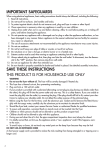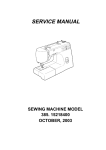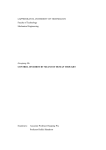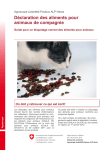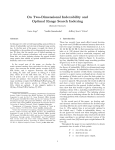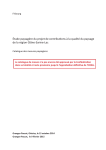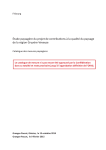Download User manual Swiss Feed Database
Transcript
User manual Swiss Feed Database Version August 2013 Content 1. System requirements ......................................................................................................3 2. Milestones and data sources ...........................................................................................3 3. Access rights ...................................................................................................................3 4. Query concept .................................................................................................................4 5. 4.1 Home page ........................................................................................................................4 4.2 Info, feedback, login, password .......................................................................................5 4.3 Summary Data (open access) .........................................................................................6 4.4 Detail Data – roughage (hay) survey (open access) .....................................................8 4.5 Detail Data – raw materials (password protected) ....................................................... 11 Data views of query reports ...........................................................................................13 5.1 Data view of Summary Data .......................................................................................... 13 5.2 Data view of Detail Data (open access restricted to hay survey) ............................... 14 5.2.1 Interactive layout ..................................................................................................... 14 5.2.2 Nutrient statistics and region comparison ............................................................. 15 5.2.3 Visualization options Google Map ......................................................................... 17 5.2.4 View of Detail Data (raw materials, password protected) .................................... 18 6. Create user defined top queries (password protected) ..................................................19 7. Downloads (password protected) ..................................................................................20 8. Contact..........................................................................................................................21 2 1. System requirements For best performance, use the latest browser versions of Chrome, Firefox, Internet Explorer or Safari. The web- Browser should support DHTML and JavaScript. In the case of using Internet Explorer version 8 or older, users are asked to install Google chrome Frame plug-in. Without this plug-in, many functions do not run properly. 2. Milestones and data sources 2007 Online database for summary data (in collaboration with the Swiss Institute of Technology Zurich, Prof. H. Hinterberger): In 2007, the Swiss online feed database has replaced the print version of the feed recommendations and feed tables for ruminants and pigs. The uploaded summary data represent curated average nutritive values on a dry matter basis which are balanced for data coherence and representativeness. Nutrient and nutritive values of over 600 raw materials and forage for ruminants, pigs, horses and poultry can be retrieved. available in German and French 2013 Extension of the feed database into a temporal Data Warehouse (in collaboration with the University of Zurich, Database Technology Group, Prof. M. Böhlen): The layout of the web interface of the extended version has been completely redesigned. In addition to summary data, also detail data (individual feed samples) become accessible which are geo-referenced and time-referenced when available. Query reports are enriched with visual tools such as charts and maps. Data upload is still ongoing and it will take some time before completion. available in German, French and English Data stem from three sources: Research Farms, feed industry, surveys Publications, feed databases The merged print version of the feed tables for ruminants and pigs, which summarize the research activities of Swiss research institutions such as Agroscope and universities, constitute the backbone of the feed database. Ongoing research projects including feeding trials and plant breeding trials will continuously provide data. Through partnerships with AGRIDEA (agricultural extension service), feed laboratories and the feed industry which regularly contribute to the data pool, we were able to extend the data basis. In this context, the yearly hay survey conducted by AGRIDEA is a valuable source for geo-referenced hay data since 2005. This data set reflects the hay quality produced under Swiss farming conditions. The inclusion of silage data is foreseen in the near future. Digestibility coefficients, for which no Swiss sources exist, are taken from publications and feed tables of foreign institutions such as INRA, DLG, CVB, ARC and NRC. 3. Access rights The access to the database and data use is defined in the terms of use which are binding to all users. The terms of use are stored under Disclaimer. The database is subdivided into an open access and password protected, paying section. The corresponding functionalities are summarized in the following table. The purchase of a password for full access rights costs CHF 150.- per year. Collaborators of Agroscope and the Federal Office for Agriculture, the e-feed group, sponsors and partners are excluded from paying the fee. 3 Access functions Open access Password protected free of charge Query summary data e-feed feed catalogue Help/Glossary Query hay survey Query detail data Downloads, data export (with collaborators of Agroscope, Federal Office for Agriculture, efeed group, sponsors, partners paying √ √ √ √ X √ √ √ √ √ √ √ √ √ √ X X X X X √ (√) √ √ √ √ (√) √ √ √ copyright) Summary data Detail data Feeding recommendations Applications Create user defined top queries (√) on request Open access are all queries relating to summary data of all raw materials and forage including detail data of the hay survey. All supplementary functionalities are password protected to which access is granted on a subscription-based procedure. Subscribers have to login to activate the extended functionalities: All queries of detail data Data export of summary data as Excel-file. Export of detail data is only available on request. Free access to the online version of the feeding recommendations for ruminants and pigs. Download of several applications and calculation programs (excel-files). Create user defined top queries (query profiles) and save for later use. 4. Query concept Due to the hosting of some parts of the database on two different servers (Agroscope, university of Zurich), it cannot be avoided that the password login has to be repeated more than once. The database can be accessed by two websites, either over the website of Agroscope http://www.agroscope.admin.ch/futtermitteldatenbank/index.html, where the files of the feeding recommendations and applications are stored, or directly over www.feeedbase.ch. The two websites are interlinked. 4.1 Home page The task bar with search options at the top of the home page is organized into a row of buttons each corresponding to a search category. Additional buttons are for option settings (info, login, language). Some buttons are loaded dynamically depending on already chosen options. In the middle of the home page, a window section is reserved for Top queries. A click on these predefined feed and nutrient combinations loads the shortcut for the corresponding query. The available examples showcase the search functionalities of the database. In the window section Sponsors, predefined, product specific top queries are stored that relate to the product range of sponsors. Institutions that regularly provide data or collaborate in some form figure under the tab Partners. 4 Home page Shortcut for predefined feed and nutrient combinations 4.2 Info, feedback, login, password The button info expands into the following list containing documents or redirecting to other websites: help (user manual), glossary with the complete feed list and nutrient list in alphabetic order, Disclaimer (terms of use), publications (redirecting to University of Zurich) and a collection of useful links. The link to the preceding version of the database is available only during the transition period. Users can send comments, wishes, suggestions, and questions or notify function disorders using the feedback form. Users must login to get access to the password protected section. The password subscription procedure is activated by clicking on the link ask for password. 5 Info, feedback, login, password language selection Feedback form 4.3 Login Summary Data (open access) The queries are constructed along the row of buttons of the task bar from left to right. Each button represents a search category starting with feed type. A click on a button expands an overlay window where the relevant search options are structured either as tab, list, and tree of check-boxes or map. Some search options are loaded dynamically based on already chosen options. Query procedure step by step: 1. 2. 3. 4. 5. Select Summary Data Select feed type (Raw materials and/or Roughage) Select Nutrients and/or Nutritive values Execute query With password: possibility to save the constructed query as a personalized top query and in addition, access to the export function. 6. Reset all search options 6 Summary data 6. reset all search options 2. select Feed type 3. select Nutrients 4. execute query 1. select Summary Data additional information in the e-feed catalogue select one or several feed types search by keywords confirm selection expansion of the selection tree by clicking on the plus sign confirm selection search by keywords 7 Is a feed type accompanied by the sign, then the link redirects to the e-feed-catalogue (online elearning tool in feed science) containing a short feed description and indications for feeding restrictions. However, the e-feed-catalogue is not available in English yet. Selection options must always be confirmed by clicking on the ok button. By default, nutrients are displayed in g, mg or MJ per kg of dry matter (DM). If the as-fed basis is preferred, then the option g/kg FM has to be selected. By clicking on the home button, all search options are The query is started with the loupe sign reset. 4.4 Detail Data – roughage (hay) survey (open access) The Roughage survey is conducted yearly by AGRIDEA, the Swiss extension service, in collaboration with several feed-stuff laboratories. Feed samples are taken on farms and thus reflect the roughage quality under farming conditions. In most cases, proximate analysis is based on Near Infrared Spectroscopy as routine analysis. The query schema is identical to Summary Data queries except that additional buttons – Time and Geo – are loaded containing tabs for temporal and geographic search options. Roughage survey 1. Select Detatil Data 2. select Feed Type confirm selection 8 3. select Nutrients In contrast to Summary Data, in Detail Data mode nutrients are loaded dynamically depending on the already selected feed type. The available nutrients are listed in alphabetical order. At least one nutrient must be selected and must be confirmed by ok. confirm selection 4. select Time: time periods may be selected but must not. If no selection is done, then no time restriction applies and all time stamps are considered. 9 5. Geographical selection: Canton and Altitude may be selected but must not. If no selection is done, then no Geo restriction applies. The tab Radius refers to a tool enabling refined geographic search on a user defined, local level. To activate the radius search, a village name or zip code must be inserted in the address field and the size of the radius (5, 10 or 25 km) be selected. By clicking on the search button, the perimeter of the local search restriction is drawn on the map. The selection must be confirmed by ok. 6. execute query execute search insert village name or zip code define radius confirm selection 10 The buttons Biology and Technique will be activated at a later date. As above, queries are executed with click on Nutrients of the roughage survey are displayed in g per kg of dry matter. By clicking on the home button, all search options are reset. Detail Data – raw materials (password protected) 4.5 Except for the roughage survey, all further Detail Data of raw materials and forage are password protected and are only available on a subscription-based, paying access. Subscribers have to login to activate the extended functionalities Once logged in, additional search menus are loaded: 1. Feeding recommendations redirection to website of Agroscope (see chapter 7, Downloads) 2. Applications redirection to website of Agroscope (see chapter 7, Downloads) 3. Tab my Queries (see chapter 6, Create user defined top queries) The query schema is analogous to the roughage survey except for additional functionalities: 1. 2. 3. 4. 5. 6. 7. 8. Login with user name and password Select Detail Data Select Feed Type (Raw materials and/or Roughage) Select Nutrients and/or Nutritive values Select time options Select geographic options Execute query With password: possibility to save the constructed query as a personalized top query (see chapter 6, Create user defined top queries) 9. Reset all search options Detail Data query 1. login with user name and password 3. 4. 5. 6. 7. execute query 2. select Detail Data 11 3. Select Feed Type On Detail Data mode, only those feed types which have been uploaded are listed in the selection tree. As data curation is a time consuming process, it will take some time until all feed types become available. At least one feed type must be selected. confirm selection 4. Select Nutrients Nutrients are loaded dynamically depending on the already selected feed type. The available nutrients are listed in alphabetical order. At least one nutrient must be selected. confirm selection Time options and geographic options may be selected but they must not be restricted explicitly. Without marked check-boxes, data is assumed unrestricted and taken completely. The query procedure is the same as described above in chapter 4.4. As above, queries are executed with click on Nutrients are displayed in g per kg of dry matter. By clicking on the home button, all search options are reset. 12 5. Data views of query reports 5.1 Data view of Summary Data The results of Summary Data queries are displayed as sortable table, one nutrient per column and one feed type per row. By moving the horizontal and vertical scroll bars, the complete report can be investigated. Row number (data records) is limited to 50 at the most. To display the next 50 rows, the arrow at the lower left corner has to be activated. A click into any column heading sorts the table in ascending or descending order. A click into a nutrient field expands an overlay window with additional information such as sample count, formula used for computation of derived nutrients, date of last update. This information display also serves as orientation help in very large tables since feed name and nutrient definition is always given. Feed type and/or nutrient selections can be modified (add, delete) at any time. To activate the change, the query must be run again with click on the loupe Data view of Summary Data a click into any column heading sorts the table in ascending or descending order a click into a nutrient field expands a window with additional information arrow leads to the next 50 data rows 13 In the password protected mode, the query results can be exported as Excel-file for further data use. Data export 5.2 Data view of Detail Data (open access restricted to hay survey) 5.2.1 Interactive layout The query results of Detail Data are displayed in three interacting windows each providing a specific data view: Google Map Scatter plot, statistic, region comparison Sortable list The tabulated list of individual feed samples is interlinked with visual tools which interact when clicking on an individual sample on the map, the scatter plot or table row. Only geo-referenced feed samples are displayed on the map by a marker. The visualization options facilitate data interpretation and data analysis. By default, result display is limited to 150 individual samples as a large data volume will result in communication delays and may affect the performance. The result size can be modified manually by adjusting the number of shown results with the help of the button Advanced Options (see below). Thereby, all views of a given query result are adjusted to the updated result size. 14 when zooming in, individual markers become visible denoting sample locations update number of results and confirm by ok button Example of a query result based on the hay survey aggregated display of sample origins using Google Map selection of up to 3 different nutrients zoom function window size can be modified click on individual point corresponding origin and row entry are highlighted. sortable columns 5.2.2 Nutrient statistics and region comparison Statistical details extracted from chosen nutrients can be selected in the drop-down menu placed at the top of the scatter plot window section. Sample count, min, max, average and standard deviation are shown. In the same drop-down-menu, the tool one-to-many-regions comparison can be activated (see below). 15 Nutrient statistics select Statistics of nutrients One-to-many-regions comparison: this tool computes the top 30 most similar or most dissimilar regions for a selected nutrient and a defined target location based on the probability of similarity. The underlying statistical procedure is a t-test. Procedure: select target region by clicking the select location button. Move the cursor to a chosen target location and click on an individual marker on the map, select nutrient, choose radius, select similarity mode (similar or dissimilar) and click the button compute. The result is displayed as interactive list. Procedure for region comparison click on a marker of the target location choose radius select nutrient select similar or dissimilar 16 Result display of region comparison: top 30 regions having a similar NEL-content compared to the target location Escholzmatt mark rows for map display Top 30 most similar regions 5.2.3 Top 30 …. with nutrient density (NEL) in the background Visualization options Google Map With Google Map, three visualization options are available: Markers depicting the location of sample origins. Sample density: colored density distribution of sample origins derived from kernel density function. Nutrient density: computation of the spatial nutrient concentration based on the bivariate kernel regression technique. Density values are colored according to a dynamic color scale. Markers can be activated in combination with sample density or nutrient density. For meaningful, country-wide interpretation of color patterns, > 800 locations with samples are required. The georeferenced dataset of the roughage survey fulfills the required data volume for most nutrients. 17 The individual markers (flags) identifying a sample location become visible only after zooming in. For the given example, 1012 locations with hay samples are available. The density pattern shown on the left clearly identifies a hot spot in sample origin. In the case of hay samples out of the hay survey, most come from central Switzerland. Blue stands for low density, red stands for high density. The color scale is dynamically generated for each query. color scale 5.2.4 The color scale for nutrient density is dynamically generated for each query. In the shown example, Ca-content of hay samples range from 5.83 g/kg DM = blue to 14.9 g/kg DM = red. The color pattern of Ca-content indicates a mountain-valley divide. Low Cacontents prevail in low altitude locations. View of Detail Data (raw materials, password protected) Subscribers have in addition to the roughage survey access to Detail Data of raw materials. The same data views as described above are available. If for a given nutrient more than one chemical method has been applied, then the query result displays the nutrient in columns distinguished by method. Under the denomination indicative, the value for a given nutrient is aggregated over all methods according to a priority schema. This way, maximum flexibility in data analysis and interpretation is sustained. The visualization of the variation patterns along the time axis (scatter plot) is of particular interest for data exploration. For instance, possible time trends become manifest. The extent of observed variations provides the necessary indications for determining security margins. Also it proves to be a useful tool for outlier detection. 18 Query result of 578 samples of corn gluten meal 60 % (password protected) login with user name and password Imported feedstuffs or feed with unknown origin cause an empty map. for a given nutrient, methods of analysis are displayed in separate columns 6. Create user defined top queries (password protected) In the password protected mode, frequently used feed and nutrient combinations can be saved as user defined top query for later reuse. These queries are stored on the home page under the tab my queries. To create a personalized query, the usual query construction schema as described above applies, i.e. select feed and nutrient options and run the query. Then click on the button save your query. In the appearing overlay window, subscribers are prompted to provide a description for the active query under which the query is stored for later use. Personalized queries can be modified or deleted without any restriction. Personalized, saved query profiles shorten the effort to construct queries if the same feed and nutrient combinations are repeatedly and frequently used. In combination with the export function, these tailormade queries prove to be very useful. 19 Save user defined top query login with user name and password save top query 7. Downloads (password protected) A click on the button Feeding recommendations and Applications redirects subscribers to the website of Agroscope where documents and Excel-files can be downloaded. 20 Unfortunately, these downloads are not available in English yet. English speaking subscribers have to switch to German or French for downloads. Download Feeding Recommendations 8. Contact Research Station Agroscope Liebefeld-Posieux Tioleyre 4, P.O. Box 64 1725 Posieux Switzerland Tel. +41 (0)26 407 71 11 Fax +41 (0)26 407 73 00 Contact: Annelies Bracher (data curation) [email protected] Monika Boltshauser (user management) [email protected] 21






















